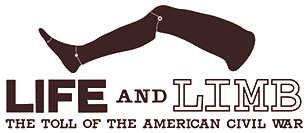
Class 3: Symbols of Sacrifice: Soldiers
Introduction:
This class broadens the analysis out from the individual soldier’s experiences of injury to consider the post-war response to the wounded veteran; in particular the symbolism of the amputee, the support he was offered, the expectations society had of him, and the particular difficulties faced by Confederate veterans who were, for obvious reasons, not offered federal funding in the decades immediately following the Civil War. The broader context within which the returning soldiers found themselves is provided by Larry M. Logue, while the representation of amputation as the symbolic wound of warfare is explored by Laurann Figg and Jane Farrell-Beck, who find that returning veterans, both North and South, were welcomed back by communities who regarded their sacrifice positively. Nevertheless, whereas Union veterans could apply for a disability pension and for funding to purchase artificial limbs, Confederate veterans relied on state support, and in the immediate post-war period this was forthcoming across most of the states of the former Confederacy.
The reading for this class should be preceded by a study of The Empty Sleeve.
Readings:
Figg, Laurann and Jane Farrell-Beck. “Amputation in the Civil War: Physical and Social Dimensions.” In The Journal of the History of Medicine and Allied Sciences 48 (1993): 454-475.
Logue, Larry M. To Appomattox and Beyond: The Civil War Soldier in War and Peace. Chicago: Ivan R. Dee, 1996, Chaps. 5 and 6.
Union: Patrick Kelly’s excellent study of the origins of modern veterans’ programs traces not just the practicalities of support but the positive longer-term implications of this support for the relationship between federal government and citizen. James Marten and the author of this module, Susan-Mary Grant, probe further some of the tensions and expectations that informed this relationship in the Civil War period.
Grant, Susan-Mary. “Reimagined Communities: Union Veterans and the Reconstruction of American Nationalism.” In Nations and Nationalism 14, no. 3 (July 2008): 498-519.
Kelly, Patrick. Creating a National Home; Building the Veterans’ Welfare State, 1860-1900. Cambridge, Mass.: Harvard University Press, 1997, Chaps. 1 and 2, Notes to Chaps. 1 and 2.
Marten, James. “Nomads in Blue: Disabled Veterans and Alcohol at the National Home.” In Disabled Veterans in History. Edited by David A. Gerber. Ann Arbor: The University of Michigan Press, 2000, 275-294.
Confederacy: Former Confederates, denied federal support, turned to their states. The case of Virginia is highlighted by Jennifer Davis McDaid, whose work on veteran records reveals the broader social impact of the war in that state, whilst Jeffrey McClurken provides an in-depth analysis of the practicalities of reconstructing Virginian veterans’ lives.
McClurken, Jeffrey W. Take Care of the Living: Reconstructing Confederate Veteran Families in Virginia. Charlottesville and London: The University of Virginia Press, 2009, Chaps. 1, 2 and 6.
McDaid, Jennifer Davis. “With Lame Legs and No Money: Virginia’s Disabled Confederate Veterans.” In Virginia Cavalcade 47, no. 1 (Winter 1998): 14-25
Discussion Questions:
- What factors influenced the federal response to wounded Union veterans? What social and familial expectations lay behind these? (See the “Rebuilding the Body” in Honorable Scars section.)
- In what ways were wounded veterans drawn into, and in what ways positioned on the margins of post-war northern society?
- To what extent were Confederate veterans ‘emasculated by their inability to earn a living,’ as McClurken proposes (p. 68)? Was this an attitude unique to the South or somehow exacerbated by the sectional nature of the support they received?


